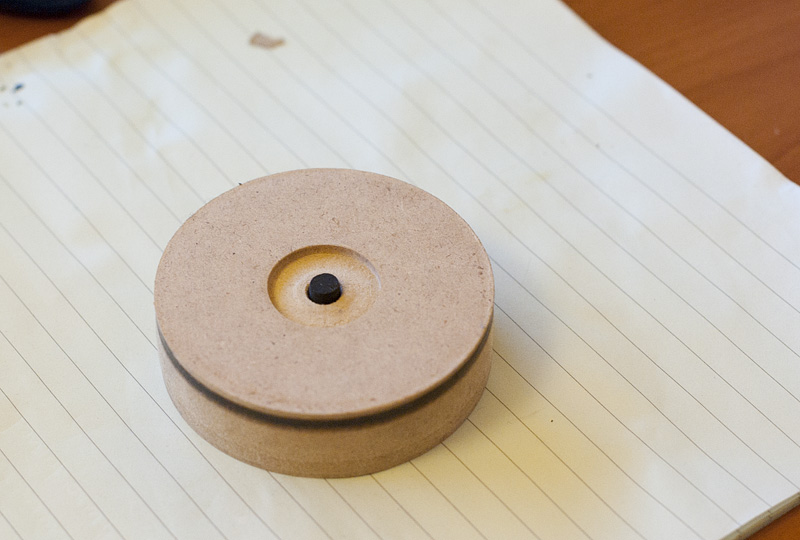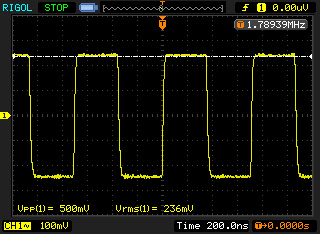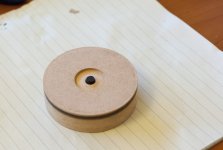Hi ,
After constructing the RCA connectors from various materials I gave a try to wood too.I've been using medium hard wood in combination with nylon tube to get mechanical strength with nice results.Your wood work motivated me to try the ebony and our Shiga is singing almost the way they are doing :
:
Listen to the lovely orchestra of crickets singing at human speed [audio] - Holy Kaw!
Thanks guys , now I understand why it is so difficult not to fall in love with that chocolate magic .
.
https://docs.google.com/file/d/0B8kj-_TTE29Vd3AzaW5MSjB3a3c/edit
After constructing the RCA connectors from various materials I gave a try to wood too.I've been using medium hard wood in combination with nylon tube to get mechanical strength with nice results.Your wood work motivated me to try the ebony and our Shiga is singing almost the way they are doing
Listen to the lovely orchestra of crickets singing at human speed [audio] - Holy Kaw!
Thanks guys , now I understand why it is so difficult not to fall in love with that chocolate magic
https://docs.google.com/file/d/0B8kj-_TTE29Vd3AzaW5MSjB3a3c/edit
Besides a Dexa reg I ordered today a couple of tubes for the PiTbull.
My plan is to rectify the voltage for the 5volt chip and listen to the results.
I chose the 6CL3/6CK3.....
Hi Erik, I was considering a similar idea, but for some reason I thought tube diodes were only suitable for rectifying high voltages... Obviously, I was mistaken in this regard. What limitations tubes carry, other than low current capacity?
Hi Erik, I was considering a similar idea, but for some reason I thought tube diodes were only suitable for rectifying high voltages... Obviously, I was mistaken in this regard. What limitations tubes carry, other than low current capacity?
Well I do not want to start pointless yes/no discussions I am more a person who tries it out himself but what could be "a negative".....the flickering of the cathode? adding noise??... but only listening will convince me
Not at all, in fact a "classic" Shigaclone is one of the most reliable players for CD-R (I say "classic" because heavily modded Shigas tend to develop issues). I have not had many problems with CDs burned at high speeds either - slow speeds are a little better, but it has not made a massive difference in my experience.
On the other hand, using a Yamaha F1 CD recorder for burning in "Advanced Audio Master Quality Recording" mode does yield a substantially more reliable CD-R, as well as audibly improves the sound (it actually comes pretty close to a pressed CD in a listening test).
Also, I noticed Shigaclones don't like Verbatim's AZO family very much (including Verbatim's "vinyl CD") - skips are much more common on those.
I have always trying to get better CD-R reading from Shigaclone
I found out that there are many brands (like Maxwell) which Is very hard TOC to be read
also my len Is not cleaned since beginning of using Shigaclone
what do you recommend to use to clean len and also are what do you recommend for a pc writer alternate to Yamaha which were masterpease but discounted
I had a late night listening session yesterday...
The thing is that fine sanding the bottom of the puck does not work at all.
The puck kept sliding on the CD and could do nothing without help from my finger pushing it a bit. Playback was OK after that, but it couldn't even cope with track changing.
Anyway... I m thinking that the proper way to get to the next level is to create complementary turntables and pucks with less mass but squeezing the CD. Like Fran's threaded puck or Erik's delrin assembly. It will also allow the use of a motor with a shorter shaft. I never liked that looooong motor axis.
The plain puck requires bigger mass to properly work without annoying stuff.
I got some thoughts, but it will require a CNC unless I can find a clever way to machine those at home with the required accuracy. It does not look good though...
Well I do not want to start pointless yes/no discussions I am more a person who tries it out himself but what could be "a negative".....the flickering of the cathode? adding noise??... but only listening will convince me
I know people that swear by tube rectification. One of them went as far as using some rare mercury ones that even have a radiation warning sticker on them.... (I think there is a thread here as well if you search for exotic set amps)
Myself I am not entirely convinced, especially because of the need for an extra transformer for their heaters. It could be interesting though. I have heard some excellent tunes coming from amps with EZ81. And it's pretty easy to test. We just have to have in mind the current demands.
You open another can of worms though with having to chose and experiment with types, makes, years of production and all the usual tube related stuff.
Now the spdif buffer is another story... I would really love to try something like that, but I do not want to have extra umbilical from the psu unit to my transport. The jfet might be a very nice solution too.
Damn you guys... as if I had few stuff on my todo list...
Last edited:
I was fooling around with more puck experiments today and just for fun i made a 73mm one made out of 20mm mdf. Well the joke was on me after all because this one gave the best sound I had so far.
This one is ~34grams which is almost half of the aluminum I ve been using so far, so it s not the weight that is doing the job.
I would say most likely the material which is rather dead sonically, and the diameter which gives a large contact area with the CD damping more vibrations, and the spread moving mass that has greater momentum and inertia stabilizing motor ticking. One thing that was annoying was that towards the end of the disk, if I skipped a track the transport needed a second or two to stabilize the speed, which was translated into some sound stutter. Probably because of that momentum/inertia.

Definitely worth further exploring...
I will try to get some 10mm mdf and repeat the experiment...
Damn... so many options... so little time...
This one is ~34grams which is almost half of the aluminum I ve been using so far, so it s not the weight that is doing the job.
I would say most likely the material which is rather dead sonically, and the diameter which gives a large contact area with the CD damping more vibrations, and the spread moving mass that has greater momentum and inertia stabilizing motor ticking. One thing that was annoying was that towards the end of the disk, if I skipped a track the transport needed a second or two to stabilize the speed, which was translated into some sound stutter. Probably because of that momentum/inertia.
Definitely worth further exploring...
I will try to get some 10mm mdf and repeat the experiment...
Damn... so many options... so little time...
Attachments
I can understand your results because the damping factor with the MDF is huge....usually useless because of the low resonance as a side effect in audio but for this purpose.
I had the same with Delrin....however the ebony puck gave it a pleasant liveliness again..so as a combo a bit of best of both worlds...
I had the same with Delrin....however the ebony puck gave it a pleasant liveliness again..so as a combo a bit of best of both worlds...
Well I do not want to start pointless yes/no discussions I am more a person who tries it out himself but what could be "a negative".....the flickering of the cathode? adding noise??... but only listening will convince me
Erik, I am hurt
I am genuinely interested in employing tube rectification, but I am aware that tubes do carry an entirely different set of limitations from silicon diodes. So my actual question was more like "What you have to give up or develop in order for tube rectification to become feasible in a Shiga".
For one, I know tube diodes have nowhere near the current capacity of the MSR860 most of us are using. Another thing is that they need an extra power supply for the heater. This should not be a problem for most people, but still remains an important consideration. And then there is the matter of voltage, which I admit have not researched thoroughly, but I got the impression that tubes only work for relatively high voltages. How you intend to employ yours?
Having done some reading, the bigger problem should be the big voltage drop and the resistive character of the tube diodes which makes the voltage dependent on current.
It will require some serious research to find a suitable tube, and will almost certainly require new transformers to handle the voltage drop with enough headroom to cover the voltage fluctuation because of current changes.
It will require some serious research to find a suitable tube, and will almost certainly require new transformers to handle the voltage drop with enough headroom to cover the voltage fluctuation because of current changes.
I agree that I will have to find out the voltage given to the tube and the drop and output...I have ordered the tubes and will give it a go with a Variac and a few transformers I have in stock...
Maybe it all goes wrong but hey...it is worth giving it a shot...
Hi Erik,
If the tubes that you ordered are too unstable depending on current in use you can always double them and get more stable operation.The problem is that you need more amperes for heaters but i am shore that you will find the way
Do I need to tell that I support your low voltage valve conquest
 ?I certainly would try it if I don't use battery for supplying the transport.
?I certainly would try it if I don't use battery for supplying the transport.Hi Erik, I am using HFA08TB60 rectifiers in my Shiga, I like them. I bought Cree Silicon carbid diodes to try in my DAC, and they are very-very good, just like the tubes. My next option is to try Cree's in Shiga too. Dimkasta, do you still use Dale resistor based L-pad in your shiga?
Besides a Dexa reg I ordered today a couple of tubes for the PiTbull.
My plan is to rectify the voltage for the 5volt chip and listen to the results.
I chose the 6CL3/6CK3.....
Hey Janos
Are you using the Cree diodes with separated PSUs for motors and digitals?
Have you compared them to the MSR860 suggested?
About the attenuator I abandoned the 12db L-Pad quite early after I measured the output with my scope. I am currently using a 14.2db T-pad made out of 50R series, 32R shunt, 50R series wirewound resistance which gives an almost perfect 0,5V square, and equally impressive sound.

However, you can still see some small stuff going on on the square. TBH I do not feel comfortable with the possibility of stray inductance from my wirewound resistors messing up. That is also why I went for the T-pad and not a P-pad, because the T uses lower values which means shorter wire length in the resistors.
Note that I do not have neither Uncle Leon's technique nor his experience to optimize my wirewound resistors, so I am once again considering something non-wirewound, but wood/wax treated, in an attempt to perfect the square and see how this goes sonically.
About Uncle Leon's 50-75 impedance suggestion, I do believe him that it sounds better and I consider him a very trustworthy fellow DIYer, but I am skeptical because it presents a lower impedance to its output and actually drives the chip near its limits. I do intent to try it though.
What is also in my todo list is the digi(lamp/fet)ishizator tried a while back by Igor and reminded to us recently by Erik.
Probably the fet though because I do not want to use big voltages.
Are you using the Cree diodes with separated PSUs for motors and digitals?
Have you compared them to the MSR860 suggested?
About the attenuator I abandoned the 12db L-Pad quite early after I measured the output with my scope. I am currently using a 14.2db T-pad made out of 50R series, 32R shunt, 50R series wirewound resistance which gives an almost perfect 0,5V square, and equally impressive sound.

However, you can still see some small stuff going on on the square. TBH I do not feel comfortable with the possibility of stray inductance from my wirewound resistors messing up. That is also why I went for the T-pad and not a P-pad, because the T uses lower values which means shorter wire length in the resistors.
Note that I do not have neither Uncle Leon's technique nor his experience to optimize my wirewound resistors, so I am once again considering something non-wirewound, but wood/wax treated, in an attempt to perfect the square and see how this goes sonically.
About Uncle Leon's 50-75 impedance suggestion, I do believe him that it sounds better and I consider him a very trustworthy fellow DIYer, but I am skeptical because it presents a lower impedance to its output and actually drives the chip near its limits. I do intent to try it though.
What is also in my todo list is the digi(lamp/fet)ishizator tried a while back by Igor and reminded to us recently by Erik.
Probably the fet though because I do not want to use big voltages.
Dimkasta,
Please correct me if I'm wrong, Igor mentioned once in this thread (but i couldn't find it) that he didn't like the sound of the jfet and he was considering on trying out the tubes. pease do report your findings whenever you got to try it.
I will be using a pi pad out of LDRs soon, i will get to compare it against my current setup, caddocks on shunt and shinkoh on series.
Btw, do you use manganin for your resistors?
Please correct me if I'm wrong, Igor mentioned once in this thread (but i couldn't find it) that he didn't like the sound of the jfet and he was considering on trying out the tubes. pease do report your findings whenever you got to try it.
I will be using a pi pad out of LDRs soon, i will get to compare it against my current setup, caddocks on shunt and shinkoh on series.
Btw, do you use manganin for your resistors?
Dimkasta,
Please correct me if I'm wrong, Igor mentioned once in this thread (but i couldn't find it) that he didn't like the sound of the jfet and he was considering on trying out the tubes. pease do report your findings whenever you got to try it.
I will be using a pi pad out of LDRs soon, i will get to compare it against my current setup, caddocks on shunt and shinkoh on series.
Btw, do you use manganin for your resistors?
I think he was happy with jfet version. Or he wanted to try the tube version but he was busy elsewhere... Something like that. He s active again so I hope he ll jump back in and let us know his final verdict
I think my wire was constantin
- Home
- Source & Line
- Digital Source
- Finally, an affordable CD Transport: the Shigaclone story
